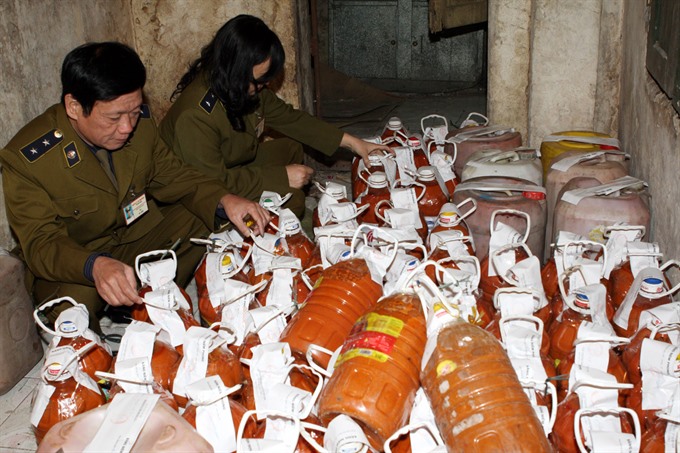 Society
Society

A plan of supervising the amount of aflatoxin, a type of mold that is considered a human carcinogen, should be implemented in all steps from harvesting, processing to storing food, plants and grains to reduce toxic exposure to consumers, health experts have said.
 |
| Hà Nội market surveillance inspects chilli sauce without labels and origin. - VNA/VNS Photo Trần Việt |
HÀ NỘI – A plan to supervise the amount of aflatoxin, a carcinogenic mould, in food should be implemented from harvesting, processing to storing food, plants and grains to reduce toxic exposure to consumers, health experts have said.
The request was made after the HCM City’s Pasteur Institute this week announced the results of a survey on samples of dried red chilli, which were all contaminated with aflatoxin.
This May and June, scientists from the institute collected 48 random samples of dried red chilli samples in markets in five cities and provinces of HCM City, Vũng Tàu, Bình Phước, Bình Dương and Đồng Nai for tests.
All of the collected samples tested positive for aflatoxin B1, the most toxic moulds of this type. Ten of the samples were contaminated with more than five microgrammes of aflatoxin B1 per kilo, above allowed levels.
Currently, the allowed level of aflatoxin B1 is a maximum of five microgrammes per kilo for agricultural products, according to the Ministry of Health.
Aflatoxin is found in commonly eaten foods. The species of moulds that combine to form aflatoxin grow in soils in certain conditions, including when decaying food, plants, hay and grains are piled together to decompose in areas with high moisture and high temperatures.
At least 13 types of aflatoxin toxic moulds have been identified. Of them, aflatoxin B1 is considered the most toxic, capable of causing health problems such as liver disease or cancer, autoimmune responses, digestive issues and even death.
Lê Thị Hồng Hảo, director of the National Istitute for Food Control told danviet.com.vn that fungal toxic contamination on agricultural products and food in Việt Nam was mainly due to improper preservation.
The risk of aflatoxin contamination would be very low if mouldy food was not consumed.
Hảo said ethnic minorities in the northern mountainous region who preserve maize for a long time would be at high risk of being poisoned. In recent years, there have been cases of corn cake poisoning, caused by aflatoxin B1 consumption.
She suggested consumers and manufacturers preserve food properly to ensure no fungal toxins are produced during storage processes.
PhD Nguyễn Duy Thịnh of the Hà Nội University of Technology’s School of Biotechnology and Food Technology said that people assumed that moulds would be killed when food or agricultural products were dried by the sun.
In fact, some moulds temporarily become dormant and then become active again and produce aflatoxin in high moisture and high temperatures.
Even when cooked under high temperatures of more than 200 degrees Celsius, aflatoxin does not evaporate, he added.
PhD Phạm Duy Quang of the HCM City’s Pasteur Institute’s Department of Diseases Prevention and Control said that to control aflatoxin contamination in food, comprehensive measures from production, trading, management and consumption must be implemented.
The key factor, he said, was tight management of the food chain from farm to table.
Those who produced, processed and traded food should control the temperature and moisture. Inspectors need to tighten supervision to ensure no products with excessive aflatoxin are sold. Consumers should choose products with sufficient labelling and origin to avoid being exposed by toxic chemicals, he added. – VNS




